SMADC maintains a varied collection of support services for farming in the region, and is constantly evaluating its existing programs to insure they are relevant, necessary and non-redundant.
SMADC may determine that a particular program/resource is no longer needed or is now being offered elsewhere. In some cases, SMADC works with partner agencies from the start to create, launch or incubate a program that the partner agency will maintain. In other cases, SMADC’s program serves as a prototype that other agencies may replicate.
Continuing Education
Ag Continuing Education Classes in Southern Maryland
The Southern Maryland Agricultural Development Commission (SMADC) & University Of Maryland’s Institute Of Applied Agriculture (IAA) developed an Ag Class Partnership For Southern Maryland Residents to earn college credits in agriculture from the University of Maryland remotely in Southern Maryland.
INAG 103 – Agricultural Marketing – 3 credits
The Southern Maryland Agricultural Development Commission (SMADC) collaborated with the University of Maryland’s Institute of Applied Agriculture (IAA) to bring the college course INAG 103 Agricultural Marketing to Southern Maryland. Through the Rural Maryland Council’s Rural Maryland Prosperity Investment Fund Grant (RMPIF), SMADC (a division of the Tri-County Council of Southern Maryland), won a grant to assist in increasing agricultural education in Southern Maryland.
This project made agricultural education from UMD more accessible to the community of Southern Maryland. We believe that encouraging students in the area to consider agricultural and agribusiness certifications and degrees could lead them to explore the idea of enrolling in certificate or degree-seeking programs within UMD’s College of Agriculture and Natural Resources. The University of Maryland is the state’s flagship institution of higher education, established in 1856 as the Maryland Agricultural College. As a land-grant institution, the University of Maryland College Park is the premiere location for agricultural academics, research, and extension. Students who enroll in these courses will earn UMD transcripted credits that can be applied toward their Certificate in Applied Agriculture, or bachelor’s degree should they decide to continue their education.
Course Description: Principles of market demand are used to develop a consumer oriented market strategy for the agricultural business. Topics include market structures, target marketing, market segmentation, niche marketing and direct marketing. Market concepts unique to agricultural products are also covered.
Learning Outcomes: When a student completes this course, he/she should be able to:
- Explain how price is determined in a market model by supply and demand.
- Use economic models to demonstrate changes in supply and demand.
- Understand the principles driving consumer decision making on agricultural purchases.
- Identify avenues for conducting market research.
- Develop a comprehensive marketing strategy for a product or service in the agriculture sector.
- Discuss current issues and trends in agricultural markets.
Course Layout: This class is held in partnership between UMD and SMADC, bringing together students from the College Park campus and remote students in Southern Maryland. The majority of participation will be via online modules on a flexible schedule, with four in-person class meetings throughout the semester. Students who do not have reliable internet access may utilize the SMADC offices where a computer and work desk will be provided upon prior reservation.
Four required in-person classes will be held in Southern Maryland for students participating through the Ag Class Partnership throughout the semester.
Enrollment and Registration Process: Open to any student from one of the five Southern Maryland Counties (Anne Arundel, Calvert, Charles, Prince George’s & St. Mary’s Counties).
Scholarship: SMADC offered $500 scholarships on a first come first serve basis to students from Southern Maryland who are enrolled in INAG 103: Agricultural Marketing. *Scholarships awarded will be funded by additional SMADC funds, not by RMPIF Grant Funds
Costs of the Ag Class Partnership program include:
- A one-time application fee of $75.00
- Standard University of Maryland in-state undergraduate student tuition and fees
- For one 3-credit course: $1,471.00
- Textbook costs will be covered by SMADC
About the Institute of Applied Agriculture
The Institute of Applied Agriculture (IAA) offers a 60-credit academic certificate program in the College of Agriculture and Natural Resources (AGNR) at the University of Maryland, College Park. The IAA provides students with the entrepreneurial, technical, and communication skills needed to manage profitable agricultural enterprises, including golf courses, sports fields, horticulture businesses, landscaping companies, and sustainable farming operations.
The Ag Class Partnership will enroll Southern Maryland students at the IAA under the Continuing Education program (details below). Ag Class Partnership students will be accorded all the benefits that are offered to all other IAA students. Regardless of their remote student status, participants who apply through this partnership program are welcome to access all of the world-class resources available on the University of Maryland College Park campus. Additionally, Ag Class Partnership students are eligible to receive student support services, including one-on-one advising from IAA faculty, the IAA Student Services Coordinator, AGNR academic peer mentoring, the Health Center, Learning Assistance Services, the Writing Center, the Career Center, the Dingman Center for Entrepreneurship, the Office of Veteran Student Life, and access to hundreds of clubs and intra- and extramural activities.
About Continuing Education Status
The Continuing Education student status at the University of Maryland is designed for those who want to enroll in select IAA courses without completing the entire Certificate in Applied Agriculture program. If Continuing Education students wish to complete the two-year, 60 credit certificate, academic credit for courses taken under Continuing Education status may be applied toward it. Enrollment in certificate-seeking status simply requires the student to fulfill the remaining regular admission requirements (providing SAT or ACT scores, or passing Math and English entrance exams). Tuition, fees and grading options are the same for Continuing Education students as they are for students enrolled in the IAA’s certificate program. Continuing Education students may register for a maximum of two courses per semester and must meet all course prerequisites.
 Funding Support
Funding Support
Rural Maryland CouncilThis workshop is made possible in part by a Rural Maryland Prosperity Investment Fund Grant (RMPIF) awarded to SMADC, a division of the Tri-County Council for Southern Maryland.
Cornelia & The Farm Band
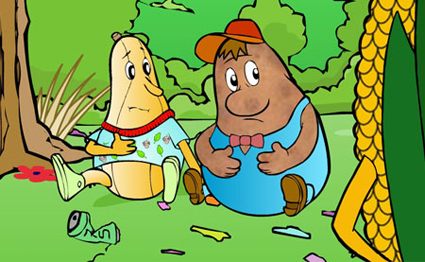
Cornelia and the Farm Band
The Cornelia program, which includes coloring books, animated videos, live videos and two life-size, mascot characters (Cornelia and Couch Potato), teaches children about the importance of an active, healthy lifestyle in an effort to combat childhood obesity and enhance the role farms play in healthy eating and exercise.
SEE THE PROGRAM WEBSITE FOR COMPLETE DETAILS
Videos
LET’S GO TO A FARM!
- website featuring cartoons, coloring sheets, games and songs that encourage an active lifestyle and healthy eating
- two coloring books (one featuring kid-friendly recipes) available free to schools and at the county fairs and other venues
- a series of seed packages with educational messages (distributed to classrooms and at the county fairs)
- five public service videos featuring animated versions of the Cornelia characters
- a life-size version (mascot costume) of both Cornelia and Couch Potato
- educational materials, including sing-along songs, coloring books, etc. distributed each year during Farm to School Week (and available for distribution to classes and clubs)
- a certified curriculum geared for fifth-grade classrooms focusing on farm facts
- a dedicated FACEBOOK page with program updates, schedule of Cornelia events, etc.
- a dedicated Twitter feed
If you are interested in ordering Cornelia materials for your classroom or club, CONTACT SMADC.
Crop Hop
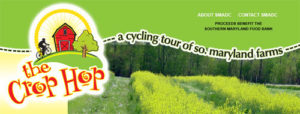
The Crop Hop
In 2012 SMADC was looking for a creative way to engage and educate the community about the importance of farms and fresh food. The Crop Hop– A Cycling Tour of Southern Maryland Farms was designed to provide a fun and healthy way to learn about Southern Maryland’s diverse agriculture, and raise funds to provide fresh, local farm products to low-income communities in Southern Maryland. The event was for all riders, including avid cyclists and families. The Crop Hop was a success from the beginning, attracting riders from around the DC metropolitan area and as far away as Massachusetts. The Crop Hop was held twice in St. Mary’s county, Charles and Prince George’s counties.
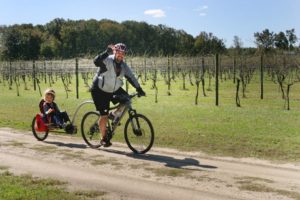
The Crop Hop had three goals:
- Connect people to the local food system by improving their understanding of local farms
- Promote healthy living through a diet of fresh, local foods and physical activities such as bicycling
- Support those who can’t afford to buy locally produced foods by donating proceeds to a local anti-hunger organization to purchase and distribute fresh local foods
Event highlights:
- Four routes to accommodate all skill levels
- Several farms featured as “Crop Hop Stops;” farms offer tours and educational presentations to riders
- Streamlined on-line registration system for riders and volunteers
- A free meal featuring local farm food and meat, and a free T-shirt to each registered participant
- Promotional and marketing support from SMADC to participating farms and sponsors
- a dedicated FACEBOOK page
- a dedicated TWITTER feed
Hub & Spoke
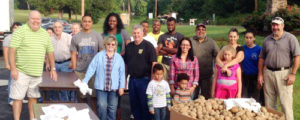
Hub and Spoke Program
PROGRAM DESCRIPTION AND HISTORY: The Hub and Spoke model of food distribution was designed to increase the availability of fresh, local farm food to the hunger community in the five counties of Southern Maryland (Anne Arundel, Calvert, Charles, Prince George’s and St. Mary’s counties).
While many anti-hunger organizations provide food for those in need, donations to these organizations tended heavily toward bulk, packaged products with a deficit of fresh produce. Moving bulk fresh produce often requires its own distribution needs. At the same time, Maryland farmers often have vegetables or fruit that are surplus or slightly blemished and therefore not marketable at full retail value. The Hub and Spoke provided a market for this produce. Notably, it provided a market for dropped accounts by large wholesalers, and an outlet for what would otherwise be considered food waste. A Maryland Hub and Spoke Task Force convened in 2013 to study the needs, challenges and opportunities of the region. The Task Force’s findings and recommendations were published in a final REPORT.
From this, a partnership between SMADC and FARMING 4 HUNGER was formed, and the Hub and Spoke model was built and tested in the region. The hope was that farmers will be offered a financial incentive for their donation through a proposed Maryland tax credit (to help cover the cost of production, harvest and delivery). The bill was brought forth in the Maryland General Assembly in FY’14 (SB0670 and HB1083), FY’15 (SB0280 and HB0359), and FY’16 (SB249 and read in the House). To date the bill has not passed, but has been favorable. Despite the passage of the bill, the program has carried on, and in many cases, Farming 4 Hunger has been able to provide a financial incentive to farmers.
In 2015, the Hub and Spoke implemented a measurement tool to assess the impact of the distribution of fresh, local fruits and vegetables from Southern Maryland farms. The objective of the survey was to gather baseline data on the clients receiving fresh food through the distribution sites. The survey provided information beyond basic measures (pounds of food delivered, number of families served, etc.) such as the extent of the unmet need for fresh food, knowledge, attitudes, and behaviors about fresh food, and the program’s impact on social well-being and community engagement. This was helpful to the program stakeholders. The findings of the survey were published in a final REPORT. The Hub and Spoke program is intended to be adaptable to the needs of any community and to be replicated and shared with other communities around the state.
Program highlights:
- SMADC funds expended to Farming 4 Hunger have amounted to $74,790, resulting in over $670,000 in revenue to 29 farms and 4,241,230 pounds of fresh, local produce.
- The program continues to make connections and partnerships with Southern Maryland farms.
- The program helped to expand the variety of produce from three types in 2013 to 20 types in 2016. Variety includes: Potatoes, Sweet Corn, Cabbage, Watermelon, Collard Greens, Cucumbers, Cantaloupe, Squash, Kale, Sweet Potatoes, Tomatoes, Zucchini, Eggplant, Lettuce, Green Beans, Peppers, Apples, and Broccoli.
- The perishable food is in its freshest state at the arrival to the Spoke sites, typically in the hands of those who need it within 24-48 hours of harvest. A truck previously drove down and back from Baltimore, to sites all over Southern Maryland; this new model for our rural area keeps locally-grown food local, and provides quality over quantity.
Food Hubs
Maryland Food Hubs
Maryland Food Hub Reports
In response to a request from the Maryland Legislature, in 2014, SMADC prepared the first summary report of emerging and existing food hubs across Maryland. SMADC conducted a study on existing and emerging food hubs in Maryland with an eye to identify collaborative and synergistic initiatives between the hubs as appropriate. SMADC undertook this report through a transparent process, inviting all hubs willing to participate. A substantial amount of initial information was compiled. A survey was then sent to all food hubs that could be identified in Maryland, with a relatively good response rate. The report helped identify areas of need and provided a blueprint for the state.
The report was shared with the food hubs and sent to the Maryland Department of Housing and Community Development and the Maryland Department of Agriculture. SMADC was also awarded grant funds to explore national trends and explore further collaborative opportunities for Maryland food hubs with the Wallace Center at Winrock International and National Good Food Network in 2015 and 2016. These findings were published to SMADC’s website, and were shared with food hubs and interested parties.
June 2016 Food Hub Report SMADC worked with Wallace Center at Winrock International on a supplemental report: MARYLAND FOOD HUBS: SCALING FOOD SYSTEM IMPACT
September 2015 Food Hub Report: EXISTING AND EMERGING FOOD HUBS IN MARYLAND 2015
September 2014 Food Hub Report: EXISTING AND EMERGING FOOD HUBS IN MARYLAND 2014
State-wide Food Hub Convenings
SMADC coordinated convenings at existing regional food hubs. Each was designed to showcase the different models in operation, and build connections between those who operate, or are thinking of operating, food hubs. Attendees toured each operation with owners and operators, and held discussions that included topics to help the audience make initial decisions. Topics included feasibility and business planning, understanding the different food hub models and how they operate, food safety and regulation updates, market pricing, transportation and distribution, and financing and raising capital. All convenings had representation from all regions of Maryland, including Western, Central, Eastern, and Southern. At some events attendees came from the surrounding regions of Washington D.C., Virginia and Pennsylvania. Many attendees were food hub operators, or emerging food hub operators. Some attendees were from food system backgrounds such as economic development and food policy, and brought a lot to the table during the discussion and Q&A sessions. One attendee wrote us after a convening and said, “Thank you for orchestrating this. Bringing the local food systems activist, practitioners and supporters together was an invaluable opportunity to share and network for the greater good of developing the Maryland local food system.” SMADC sees value in working together and places importance in continuing to pursue these endeavors and share lessons learned, cross-market, and work collectively as needed.
Timeline of Convenings:
- July 2014: Town Creek Foundation hosted the first-ever convening of food hubs in Maryland. The event was well received and many requested for the meetings to continue.
- July 2015: SMADC saw tremendous worth in sharing lessons learned, cross-marketing and working synergistically where possible, and therefore offered to help coordinate additional convenings.
- With funding from Town Creek Foundation, SMADC and the Wallace Center hosted a training session for Emerging and Early Stage Food Hubs in Anne Arundel County.
- November 2015: SMADC and other existing and emerging food hubs met for a tour and convening of Common Market, one of the oldest Food Hubs in the Mid-Atlantic.
- January 2016: SMADC and the Wallace Center held a discussion session about regional food hubs at the Future Harvest CASA annual event.
- May 2016: SMADC and existing and emerging food hubs met for a tour and discussion of Friends and Farms, a Maryland food hub. The tour was followed by a discussion with the Maryland Food Center Authority, the Wallace Center and other stakeholders about research underway on the existence of and potential for food hubs in Maryland.
- June 2016: SMADC and existing and emerging food hubs met for a tour and discussion of Chesapeake Farm to Table, a Maryland food hub. The final Wallace Center report was shared during the convening.
Southern Maryland Food Hub / Agricultural Business Park and Food Innovation Center
SMADC is in the process of developing a food hub for Southern Maryland. The first need identified by the community is for a reginal meat processing facility. More information and a timeline of this project can be found here.
Partners: Town Creek Foundation, The Wallace Center
Farmers' Markets (EBT Program, Grants, Survey)
Farmers’ Markets (EBT Program, Grants, Survey)
SMADC Grants to Markets for EBT Terminals
In 2012, SMADC offered small grants to farmers’ markets in the region to encourage the leasing of Electronic Benefits Transfer (EBT) machines. An EBT machine is a point-of-sale terminal that allowed a vendor or retailer to accept SNAP benefits.
And in August of 2012, SMADC was awarded a Maryland Agricultural Education and Rural Development Assistance Fund (MAERDAF) grant to assist farmers’ markets in applying for a USDA grant to receive an EBT machine and provide administrative support, stipends for onsite management of the EBT machine during market, and funds for incentive dollars.
Farmers’ Market Surveys
In the summer of 2012, SMADC began conducting surveys of consumers at various markets in Southern Maryland to better understand the economic and social dynamics of local farmers’ markets and their influence on their local food and business communities. By analyzing the data, SMADC will be able to determine roughly how much a “buying group” (between 1.6 and 2 people) spend on a given day and estimate the daily sales of the market. Analysis of the responses will enable SMADC to better understand the pull of the market for consumers and whether it, as an individual entity, is bringing consumers to a defined location.
Food & Farm Map
Southern Maryland Food and Farm Map
The Southern Maryland Food and Farm map was last updated in 2015. At this time, SMADC does not have funds to maintain and update the map. (You can see the most recent version of the map HERE.) A current, active statewide map is available through Johns Hopkins Center for A Livable Future.
In 2014/15, SMADC partnered with Johns Hopkins Center for a Livable Future in its efforts to create a comprehensive, interactive food map of the five Southern Maryland counties, to be included in the Center’s state-wide food map. This unique resource was created to present the local food system geographically and to spur improvements by indentifying obstacles and opportunities in the food system.
The Southern Maryland Food and Farm map identified:
- Farms, farmers’ markets and farm stands
- Supermarkets and small food stores
- Food deserts
- Food banks/warehouses
- Overlapping layers of income, population, and health statistics
- Schools that provide free and reduced meals (FARM) to children
- Nutrition assistance offices (SNAP, WIC)
- Hub and Spoke locations for distribution for the hunger community
- Public transportation lines
How to use the map: Check the boxes of interest under the tab marked LAYERS at the top of the navigation panel to the left of the map. (Check multiple boxes to view overlapping layers of data.) Use your mouse and the plus and minus symbols in the upper left corner of the map window to pan and zoom. (On a mobile device, swipe and pinch to pan and zoom.) To see a symbol key and a breakdown of the color codes, click the LEGEND tab.
Sources for MAP data: SMADC used GIS and other mapping technology to study the food system in Southern Maryland. The data were mostly from primary data collection, and also includes federal, state, and local government agencies, and project partners. To see a description/definition of each data layer along with a list of sources for that data layer, see this MAP DATA SOURCE PAGE.
Partners: Johns Hopkins Center for a Livable Future, Town Creek Foundation, Calvert County Government, Department of Community Planning and Building.
Food Council
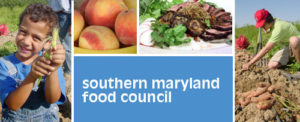
Southern Maryland Food Council
SMADC supplied resources, staff support and funding to form a regional food council designed to bring together diverse stakeholders to integrate critical aspects of the regional food system in order to sustain and enhance the environmental, economic, social and nutritional health and sustainability of Southern Maryland.
SMADC administrative support for the Southern Maryland Food Council (SMFC) ended in July of 2016. The council now functions independently, however SMADC remains a member and continues to participate when appropriate.
Any interested member of the community is welcome to attend SMFC meetings (including committee meetings), to participate in ongoing projects, to join in general discussions and to bring ideas before the Council.
- SMADC initially conducted initial outreach and provided meeting facilities and administrative support to assemble members of the community active in (or interested in) improving the region’s food systems
- SMADC provided and maintained marketing support and branding to promote the Council, including developement of a website, logo and social marketing presence
- SMADC provided staff support and hosting for the Council’s annual, region-wide Foodways Networking Event, which were well attended and well-reviewed by the community
- Initial resources, staff support and funding to create and launch the Southern Maryland Food Council were provided by the Southern Maryland Agricultural Development Commission
So. Maryland, So Good
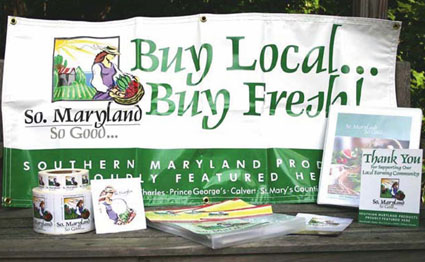
So. Maryland, So Good
The So. Maryland, So Good logo symbolizes fresh, quality farm food grown right here in Southern Maryland. Through this, Southern Maryland’s “Buy Local” program, SMADC educates consumers on how, why and where to buy local farm products and provides farmers with extensive resources to promote their offerings.
SEE THE PROGRAM WEBSITE FOR COMPLETE DETAILS
Program highlights:
- a dedicated website designed to increase consumer traffic to local farms as well as to markets, restaurants and other venues that sell local farm products
- a juried listing of farm-to-table providers including restaurants, caterers and more
- a powerful, searchable online database of farms, vineyards and agri-tourism destinations, as well as markets, restaurants and other venues that sell local farm products
- a series of marketing materials that comprise a comprehensive inventory of the region’s farm products and services
- point-of-purchase signs, banners, labels, etc. that identify farm products as part of the So Maryland, So Good brand
- ongoing marketing support for the brand, including SMADC-funded advertising in county and regional publications
- advertising opportunities for SMSG farms and businesses in various publications
periodic training (workshops and seminars) for SMSG participants
START Farmers' Network
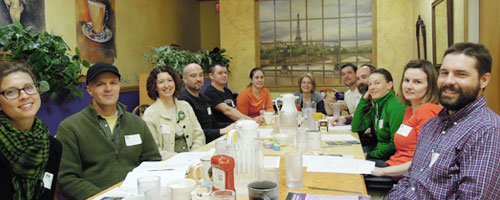
The START Farmers’ Network
START (Starting, Transitioning And ReTurning) Farmers’ Network (a program of Maryland FarmLINK and the Southern Maryland Agricultural Development Commission), provided assistance and resources to new, young and beginning farmers. Formed in 2013, the group met approximately monthly to network, discuss challenges, hear from experts and guest speakers, tour successful farms and more. Several other new/young farmer groups came into being after START was created, and the group was discontinued in 2017.
MEMBERS: Any beginning or transitioning farmer was welcome to join START. Simply attend a START meeting. There was no formal application process, and no fee to participate.
MEETINGS: START Farmers’ Network alternated its meetings between locally-sourced restaurants, SMADC offices and farms. Information about upcoming events and START meetings were posted to the Maryland FarmLink Facebook page and Twitter page, along with local, state and national farming news.
EVENTS: START hosted a handful of field trips and farm tours throughout the year.
RESOURCES: START members had access to SMADC’s BEGINNING FARMER RESOURCES webpage, with resources geared specifically for new, young and transitioning farmers, and SMADC’s main FARMER RESOURCE page, which lists a wide range of resources for all farmers.
